
This is a complete guide to chord contruction with simple rules that broke me out of my playing rut. You’ll learn how to construct chords using two methods, how to name chords, how chords relate to each other, simple rules to remember chords, and a lot more.
Buy the PDF Version of this Lesson
This is a complete guide to chord contruction with simple rules that broke me out of my playing rut. You’ll learn how to construct chords using two methods, how to name chords, how chords relate to each other, simple rules to remember chords, and a lot more.
Why Chord Construction is Useful
When I was improvising for the first time, I memorized scale patterns. This was so much fun because I could suddenly solo over a lot of chords and songs. The pattern made it easy, but I started to play the same licks over and over. I couldn’t break this rut because I didn’t truly know the notes of the chords that I was playing over or the notes of the scale pattern that I was using. As a result, my playing became boring.
When I learned the chord tones, I was able to locate and play chord tones and think musically. I didn’t just learn the notes, I started to own the notes and make them work for me. This lesson covers everything you need to know about chord construction along with my practical tips and intuition to make it easy to learn.
This lesson requires some knowledge of intervals. If you don’t know them yet, I recommend reading my intervals lesson. You should also know the major scale since it is used in one of the two methods of chord construction. You can also find this information in Guitar Lesson World The Book.
Three Types of Chords
For practical purposes there are a three different types of chords that you should know. I’m not talking about chord qualities, rather I’m talking about categories of chords. These are triads, seventh chords, and extended chords.
Triads
Triads are 3 note chords. They can be major, minor, diminished, augmented, or suspended chords. Although triads are exactly 3 notes, you can play major, minor, diminished, augmented and suspended chords with more notes by simply doubling some of the notes. All the CAGED chord forms that most beginners learn use double notes.
Seventh Chords
These are 4 note chords that have a seventh degree, which is a note that is usually a major or minor seventh interval above the root. The most common seventh chords are major 7, minor 7, and dominant 7.
Extended Chords
Extended chords are simply chords that contain a ninth, eleventh, or thirteenth. These are considered the extended notes. You should notice that they could also be considered the 2, 4, or 6. For example, in the key of C, the 2nd and 9th are both D. The 4th and 11th are both F. The 6th and 13th are both A.
You might be wondering why we even bother to use the names 9, 11, 13, when 2, 4, and 6 are the same notes. There are a few reasons. The easiest reason is that 9, 11, and 13 are used when you extend seventh chords. The highest degree of a seventh chord is the 7th, they are extended with higher numbered notes.
2 Ways to Learn Chord Construction
There are two common ways that people teach chord construction. Each has their pros and cons. I like to teach both of them because they are both useful in their own way.
Method 1: Formula + Major Scale
If you know the major scale, this is an easy approach.
- You choose a root note, such as C
- You get its major scale notes: C-D-E-F-G-A-B.
- You apply a chord formula from a list, which I’ll provide later.
For example, the chord formula for major chords is 1-3-5. We take the first, third, and fifth note of the major scale to create this chord. So a C Major chord has the notes C-E-G.
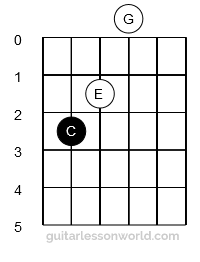
Some formulas modify one of the degrees with an accidental. For example, the minor chord formula is 1-♭3-5. This means that a C minor chord has the notes C-E♭-G.
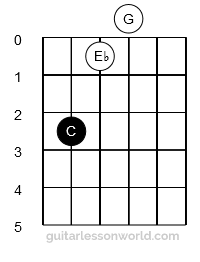
It is important to note that chords can double notes. For example, C Major in open position doubles a C (2nd and 5th string) and an E (1st and 4th string).
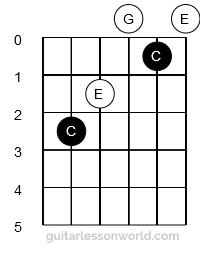
Because the major scale has 7 notes, you may be wondering how we play the extended chords, which include a 9, 11, or 13. You simply repeat the note names. For example, the notes of the C major scale (repeated) are C-D-E-F-G-A-B-C-D-E-F-G-A-B.
| 1 | 2 | 3 | 4 | 5 | 6 | 7 | 8 | 9 | 10 | 11 | 12 | 13 | 14 |
| C | D | E | F | G | A | B | C | D | E | F | G | A | B |
You can find a listing of all the major scale notes and chord formulas in my resources section.
Method 2: Intervals
Chords can be formed using interval formulas, which I will give in a later section. These can be given as the interval from the root or relative to the previous note. If you need to refresh your knowledge of intervals, I recommend reading my lesson on intervals.
Relative to the Root
If you are forming a C Major 7 chord with the root intervals, you would use the following formula: major third, perfect fifth, major seventh.
In other words, the notes are C (the root), E (a major third up from C), G (a perfect fifth up from C), and B (a major seventh up from C).
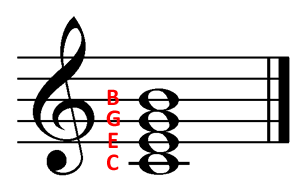
Relative to the Previous Note
Sometimes intervals are specified relative to the previous note because chords are (usually) stacked in thirds. For C major 7, the formula would be major third, minor third, major third. The notes are C (the root), E (a major third up from C), G (a minor third up from E), and B (a major third up from G).
Observe the alphabetic distance between the notes. C to E is a major third. It is a third because it spans 3 alphabetic note names C-D-E. It is major because C and E are 2 full steps apart in pitch. E to G is a minor third because it spans 3 alphabetic note names, E-F-G, but E and G are only 1-1/2 steps apart. Knowing this will help you identify the pitches of the chord.
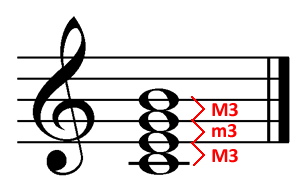
Some musicians say that chords are stacked in thirds because they are stacked one on top of each other on the staff, as shown above.
Knowing that most chords are stacked or spelled in thirds is useful and will help you identify the notes and play more thoughtfully.
Chord Formulas
The following list provides the formulas. This probably covers 90% of the chords that you’ll encounter. The others can be derived with a working knowledge of chord construction.
Triad Formulas
Most triads contain a root, third, and fifth. The suspended chords replace the third with either the 2 or the 4. These chords are named using the 2 and 4 because they are replacing the third rather than extending the chord. I will cover this in greater depth when we discuss extended chord formulas.
| Chord | Formula | Interval Formula | Audio |
| Major | 1-3-5 | Root-M3-P5 | |
| Augmented | 1-3-♯5 | Root-M3-Aug5 | |
| Minor | 1-♭3-5 | Root-m3-P5 | |
| Diminished | 1-♭3-♭5 | Root-m3-dim5 | |
| Suspended 4 | 1-4-5 | Root-P4-P5 | |
| Suspended 2 | 1-2-5 | Root-M2-P5 |
Seventh Chord Formulas
You may notice a pattern here. Seventh chords build upon triads. I listed the most common seventh chord formulas below. Take a minute to observe the triad to seventh chord relationship. For example, Major 7 and Dominant 7 add a seventh to the major triad. Later in this lesson, I will give you some simple rules to help you learn several chord patterns.
I often get asked about the double-flat on the diminished 7 chord. A double-flatted seventh is enharmonic with the 6. In other words, the pitch is exactly the same, but the name is different. It is named this way to keep the pattern of adding a 7th to a triad. For example, in the key of C, the 7th is B and ♭♭B is two semitones lower than B. It has the same pitch as A, which is the 6th note of the C major scale (C-D-E-F-G-A-B).
| Chord | Formula | Interval Formula | Audio |
| Major 7 | 1-3-5-7 | Root-M3-P5-M7 | Coming Soon |
| Dominant 7 | 1-3-5-♭7 | Root-M3-P5-m7 | Coming Soon |
| Minor 7 | I–♭3–5–♭7 | Root-m3-P5-m7 | Coming Soon |
| Minor 7 Flat 5 | I–♭3–♭5–♭7 | Root-m3-dim5-m7 | Coming Soon |
| Diminished 7 | I–♭3 –♭5–♭♭7 (or 6) | Root-m3-dim5-dim7 | Coming Soon |
Extended Chord Formulas
Below are some common extended chords. Their usefulness varies by style. Jazz musicians often start with the seventh chords, and add the extended chords over time. Blues musicians often learn the dominant 9 chord right away. Meanwhile, Rock and Pop styles use them occasionally, but you can go a long time without learning them.
You will notice that the extended chords build upon the seventh chords in the same way that the seventh chords built upon the triads. Because we’re building upon the previous chords, we are ascending in order. Therefore, we start to use the “extended” names of 9th, 11th, and 13th instead of 2nd, 4th, and 6th.
You will notice that the dominant 13 chord has 7 notes when the guitar only has 6 strings. Some notes will be omitted when you play this chord by yourself, but another band member may play the notes that you omit.
| Chord | Formula | Interval Formula | Audio |
| Major 9 | 1-3-5-7-9 | Root-M3-P5-M7-M9 | Coming Soon |
| Dominant 9 | 1-3-5-♭7-9 | Root-M3-P5-m7-M9 | Coming Soon |
| Dominant 11 | 1-3-5-♭7-9-11 | Root-M3-P5-m7-M9-P11 | Coming Soon |
| Dominant 13 | 1-3-5-♭7-9-11-13 | Root-M3-P5-m7-M9-M13 | Coming Soon |
Quick Review
- I promised a practical approach to chord construction… we’re not there yet!
- There are three main types of chords: triads, seventh chords, and extended chords.
- You can form a chord by using a formula based on the major scale or on intervals.
- Chords are built on thirds (we’ll come back to this later).
Easy Ways to Remember Chord Formulas
This is where the practical approach begins. Let’s start with some common observations.
Three Observations
- All chords except the suspended chords contain a root, third, and fifth. Suspended chords replace the third with a 2nd or 4th.
- Chords skip notes. In other words, 1 (skip 2) 3 (skip 4) , 5, (skip 6), 7, etc. In notes: C, (skip D), E, (skip F), G, (skip A), B. So the notes are C, E, G, B (for C Maj 7)
- I omitted power chords because they only contain two notes, the root and perfect fifth. The C power chord is notated as C5 and contains the notes C and G.
7 Rules to Derive the Chord Formulas
These rules are useful because they tell you the important notes for each chord quality! You can also form almost any chord with these rules.
How Chord Names Relate to 3rds, 5ths, and 7ths
- Major and dominant chords all have a major third (3)
- Minor and diminished chords all have a minor third (♭3)
- Major 7 chords have a major seventh (7)
- Minor 7 and dominant chords have a minor seventh (♭7) [in addition to the minor third (♭3)]
- Diminished chords have a diminished fifth (♭5) [in addition to the minor third (♭3)]
- Augmented chords have an augmented fifth (♯5)
- Suspended chords replace the third with a major second (2) or perfect fourth (4)
7 Rules in Table Format
| Chord | 3rd | 5th | 7th |
| Major & Dominant | 3 | ||
| Minor | ♭3 | ||
| Major 7 | 7 | ||
| Minor 7 & Dominant 7 | ♭7 | ||
| Diminished | ♭3 | ♭5 | |
| Augmented | 3 | ♯5 | |
| Sus2 | 2 | ||
| Sus4 | 4 |
Tip: Jazz musicians often focus on the 3rd and 7th of the chord. They are important chord tones that you can highlight when improvising.
Chord Modifiers
The chord formulas above cover many of the chords you’ll need to know. The following modifier rules will help you modify them to learn almost all the rest.
- Add chords – These are chords that simply add a note. For example, a Cadd9 chord is a C Major chord with an added 9th (D). Because it doesn’t have a seventh, it is not a ninth chord. For 9th chords, you need the entire sequence of root, third, fifth, seventh, ninth.
- Omit chords – These chords simply omit a note from the chord. Chords are often played with omitted notes, but it is rarely specified. When it is, the composer is stressing the need to omit that note.
- Modified Notes – You may run into chords with a modified note. Some examples include minor7♭5, which is pronounced minor seven flat five. It is simply a minor7 chord with a flatted fifth. Another example, is a modified add chord like the dominant7♯9 chord. It is simply a dominant 7 chord with an added and sharped 9th. E7♯9 or E7(♯9) is sometimes called the Hendrix chord.
Quick Review 2
Before the REALLY practical part of this lesson, let’s review.
- Chords are generally constructed in thirds, which skip every other note.
- There are some easy rules that help musicians construct and think of the chord’s harmony.
- The 3rd and 7th are important chord tones.
- Added, omitted, or modified notes can be specified in the chord’s name.
Practical Chord Construction Secrets
At this point, some teachers would instruct you to memorize several chords or stop here and let you learn chords as you need them to play a song. Neither approach is wrong, but they don’t give you intuition or simplified rules to improve your playing. In this section, I will reveal some simple rules that teach you how most guitar chords are constructed. It will help you think faster and play thoughtfully with specific notes in mind.
The Great Grip Problem
Chords on the piano are often played in an orderly fashion. In other words, the lowest note is the root, the next pitch is the 3rd, followed by 5th. It’s all neat and tidy. This order, however, is not required. Actually, guitarists rarely play the notes in this order because it is hard to grip them unless you change the order. Let’s take a look at C7 rooted on the 6th string. The first grip keeps the notes in order like a pianist would play it. The second grip changes the order of the notes to make it easier to play on the guitar.
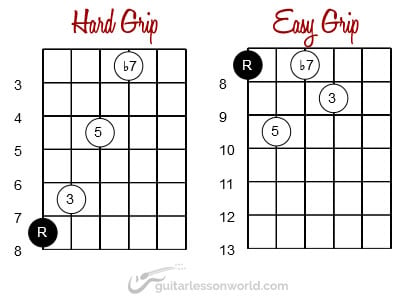
In standard tuning, playing chords like a pianist is impractical, so guitarists usually play different voicings. In guitar terms, voicings are different grips for the same chord. In more precise terms, a voicing determines the order of the notes along with which notes are doubled.
Inversions
Chord voicings that change the order of the notes are often called inversions. For example, your base triad is R-3-5. The first inversion of this chord orders the notes as 3-5-R. The second inversion would order the notes as 5-R-3. This lesson will not teach you several inversions of chords, but it is good to know. You can derive several chord grips by trying to find all the combinations. I will explore this in a future lesson, but I will give you some practical advice on forming chords with easier grips in the next couple of sections..
Solving the Great Grip Problem
The great grip problem exists because we use standard tuning, which means that our guitar is tuned in perfect fourths except between the 2nd and 3rd string where the interval is a major third. You learned earlier that chords are built in thirds (or that they skipped notes). When you want to play a third on the next string, you need to move to a lower fret almost every time. As you add thirds, the grip becomes harder and harder. For example, R to 3 spans 2 frets. When you add the 5th, the chord spans 4 frets. When you add the flatted seventh, the chord spans 6 frets. It is hard to stretch your fingers across 6 frets.
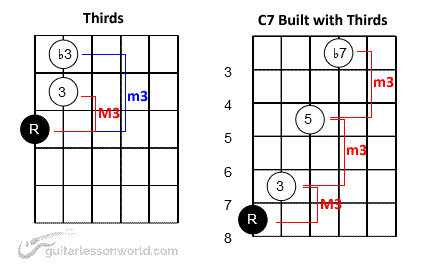
Chords are built in thirds which force you to move to lower frets on each string. We need to find a way to move forward!
The 45 Divide
The key to constructing great chords is to alternate between notes that move you up and down the fretboard. So far, we know that thirds move us backward, but what moves us forward? It is simply a higher interval, and the next chord tone after the third is the fifth. The diagram below shows the root note and the notes on the next higher string. Notice how the thirds move you back but the fifth moves you forward.
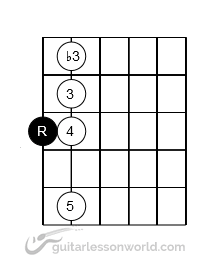
The dividing line between moving backwards and forward is what I call the 45 divide. I named it that way because of how it helps you find notes from a chord formula. The note on the same fret as the root note but on adjacent higher string is a perfect fourth. The note on the same fret as the root note but on the adjacent lower string is a perfect fifth (for chord formula purposes). Since it is a fourth one way and a fifth the other, I call it the 45 divide.
For example, sus4 chords contain a root, perfect fourth, and perfect fifth. Csus4 contains C (root), F (4th), and G (5th). If you play C on the 3rd fret of the 5th string. You will find an F on the 3rd fret of the 4th string and a G on the 3rd fret of the 6th string.
Be careful when moving between the 3rd and 2nd strings, they’re divided by a 36 divide instead (Major 3rd ascending, minor 6th descending). If you aren’t sure why, look at how the guitar is tuned or contact me for clarification.
The Complete 45 Divide
The complete 45 divide is simply the chord tones within 3 frets of the root’s fret. Let’s take a look when we’re rooted on the 6th string. I included flatted thirds and sevenths since they’re so common. Notice how you can find E-form and G-form chords in the following diagram. There are other diagrams that are rooted on different strings and correspond to the other CAGED forms.
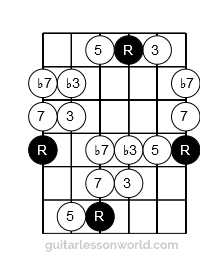
The goal of this diagram is to give you a quick reference of the chord tones.
2 Practical Formulas for the Most Common Chords
Let’s take a look at how the popular CAGED chord forms are constructed. You’ll see similar patterns.
E-Form, A-Form, D-Form: R-5-R-3-(5)-(R)
Notice how the following chords all start with the root note, then the 5th, repeat the root, then play the third. This is a very common pattern in guitar chords. I label this form R-5-R-3-(5)-(R). Optional notes are shown in parentheses.
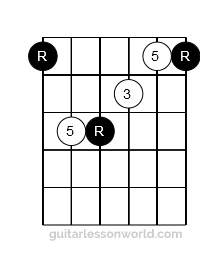
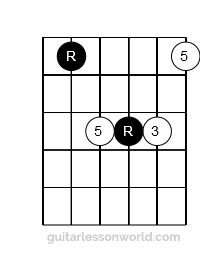
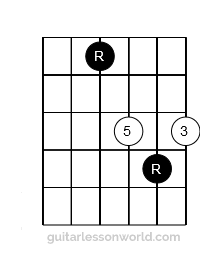
The E, A, and D Form chords use the same pattern. They just start on a different string!
C-form, G-form: R-3-5-(R)-(3)-(R)
The C and G form both play with the root, 3rd, 5th, then repeat the root. They use the same pattern: R-3-5-(R)-(3)-(R). Once again, optional notes are in parentheses.
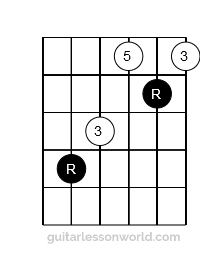
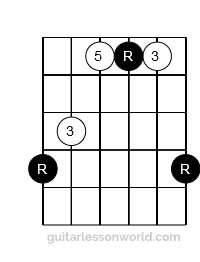
Like the The C and G Form share the same interval pattern. They simply start on a different string.
Forming Seventh Chords with Modifications
We can easily modify these chords to form seventh chords! Usually, this is done by modifying doubled notes or the fifth, which is sometimes omitted.
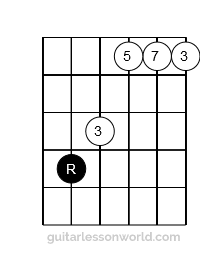
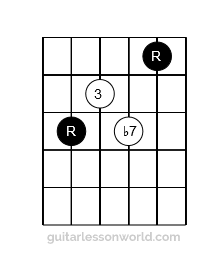
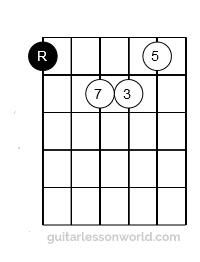
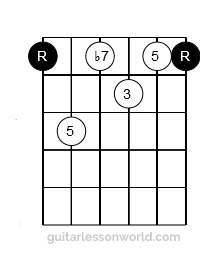
Forming Extended Chords with Modifications
Extended chords are usually formed by modifying a doubled note or one that we consciously omit. Below are examples of a dominant 9 and a dominant 13 chord.
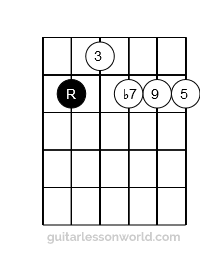
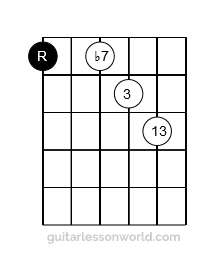
Practical Chord Construction Rules
Now let’s review what we just learned then learn a few extra rules.
Two Common Forms
Most common chords are based on the following forms.
- R-5-R-3-(5)-(R) – Used in the E, A, and D chord forms
- R-3-5-(R)-(3)-(R) – Used in the G and C chord forms.
Common Modifications to Construct Seventh Chords
- Replace doubled roots with sevenths.
- Omit or modify fifths, usually to play a seventh instead.
Chords that skip strings usually skip the string after the lowest note.
Common Modifications to Construct Extended Chords
We know that we can’t always play every note in an extended chord. We try to modify doubled notes first, but often we have to make a compromise. Usually it is using the following rules.
- Replace a root to create a 9th chord.
- Replace a fifth to create an 11th or 13th chord.
String to String Movement
You will notice that the following rules apply to almost all guitar chords when switching from a lower pitched string to a higher pitched string.
- The root either descends to the 3rd or ascends to the 5th
- The 3rd either descends to the 5th or ascends to the 7th
- The 5th either descends to the 7th or ascends to the root
- The 7th either descends to the root or ascends to the 3rd.
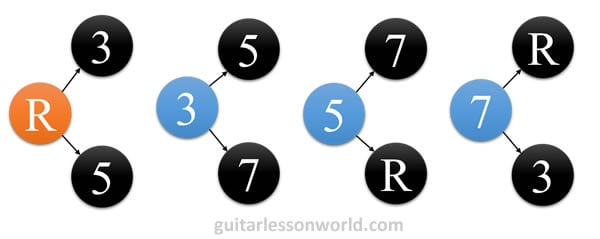
It can be simplified to an even simpler and more powerful rule:
Any interval descends to the next interval or ascends to the interval after that.
Practicing to Learn Chord Tones
Everything you learned in this lesson was intended to give you intuition and simplify the many rules. Regardless, it is still a lot of information. You still need to practice this so you don’t forget it. Here are some practicing recommendations.
What to Practice
Below is a list of what to practice in the order that I recommend.
- Learn the triads chords first: major, minor
- Learn the seventh chords next: major 7, minor 7, and dominant 7
- Learn diminished and minor 7♭5
- Learn suspended chords
- Learn augmented chords.
- Learn extended chords.
How to Practice
I recommend using the 3-3 rule. In a given week (or 7-day span), practice 3 exercises at least 3 days. Continue practicing until you truly learn the chords.
- Play the diatonic sequence in common keys. For example, in the key of C, play C, Dm, Em, F, G, Am Bdim. Then play it with seventh chords: CMaj7, Dm7, Em7, FMaj7, G7, Am7, Bm7♭5.
- Play the diatonic sequence chords, but go up a fifth then down a fourth. For example, play C, G, Dm, Am, Em, Bdim, F, C. You can play this sequence with one form (such as E-form) and move it around or you can try to stay in the same position.
- Play one chord up the fretboard using the CAGED forms. For example, play C-form, then A-form, G-form, E-form, and D-form. If one is hard to play, look for variations at the same position. Usually the G-form is hard to play, but you usually have an option on strings 1-4.
- Practice improvising over a chord progression by playing chord tones from the shapes that you know.
- Although I didn’t explain it here, you can play arpeggios and try to visualize the chord shapes that you are playing.
- Learn sets of chords, such as Drop 2, Drop 3, and Drop 2&4. These will provide several combinations of chords.
As you modify chords, listen for the differences in the chord sounds. Also, look at the differences in the grips. The goal is to learn the notes you are playing.
Conclusion
Ironically, learning chord construction helped me improvise better. I was able to understand the notes that I was playing. It helped me link melody to harmony effectively. It truly broke a rut for me, and it can do the same for you.
I am planning several new lessons that expand on this lesson. My Drop-2 chords lesson is a good follow-up lesson because it covers several combinations of chords.
This was a huge lesson. If you read this far, you must be a future guitar hero, but I want to thank you for reading it. I truly hope it helps you improve.
If you liked this lesson, please consider buying the PDF version to support content like this. Alternatively, the biggest thanks I can get is for you to like my facebook page and leave a post with what you liked about it. As always, feel free to contact me with your questions, concerns, etc. I am here to help!


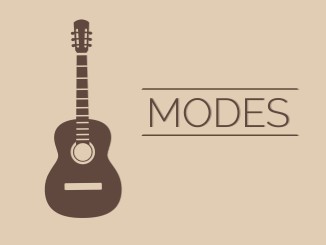
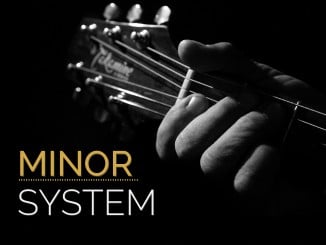
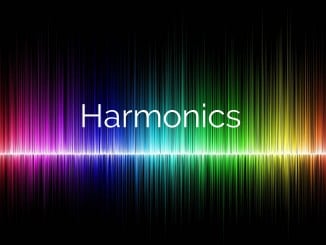
receive my sincere gratitude blessed guitarist for the awesome step by step chord construction lesson . am an absolute beginner
A truly wonderful article, You have covered everything what a guitar player needs to know, Thank you so much 🙂
Thank you for the kind words. I am glad that you found it useful, and I hope to continue to provide insights for readers like you.
I could certainly be wrong but I think there might be a mistake in the “Great Grip Dilemma” paragraph. Looking at the diagrams posted below, I think there is only a one fret difference between the root and the third on the next string up. From that, I think the other fret values may be off. Let me know if I am wrong please. Great article regardless!
Thank you for your comment and kind words. The diagram is correct. For C7, C is on the 8th fret of the 6th string and E (the 3rd) is on the 7th fret of the 5th string. If it were a minor 3rd, that would be a different story.
Pat
Great mate.. connected so many dots that my meagre and sporatic attempts to decode the guitar- music connected systems relations ships and sheet music notations on my own over the last 30 years … much appreciated…. helped me on my eternal journey to inner peace … Chuckle..
Thanks so much
Cheers
Thank you for your kind words. I’m so glad this lesson helped you, who has been playing for 30 years!
Congrats From South America.
I’m doing a research to my content, and i found your hard job.
One day i will give similiar content to my audience, my market is so newbie yet.
Good Job!
You’re a legend! I can totally relate to being stuck in a rut and I know practising this can finally win me some overdue progress. Thank you for taking the time to plan and write this. The interval chart on its own is a valuable resource. The “observations” are brilliant as well as the 5<R<3 relationship tips! I have never seen this taught this way before and it simplifies so many things that usually start to fog up in my poor brain. This is one of the best lessons I've read and I was glued after the first sentence.
I can’t say that I’m a legend, but thank you! Most of the observations and intuition were original ideas that I haven’t seen elsewhere (at least not compiled in this way. I’m glad that you enjoyed the lesson and I wish you well in your practice! Stay tuned for more free and updated lessons plus my upcoming book, The Secrets of Learning the Fretboard, that should finally be released this month!
Good site. Shall check it again later. One Q. I am still after a few years wondering why the 4th string is tuned one click lower. Why?
Thank you for the comment and the kind words.
With standard tuning, it is tuned in perfect fourths except for between the 2nd and 3rd string (which is a minor 3rd). I do not know the true reason for it, but I have always assumed that it was to make chord grips easier.
What a stunning article, thanks.
As I start to move into more and more jazz based gigs … from many years of playing the blues, I am having to go back to the theory again. This was a real breath of fresh air!
Thanks…
Ray, I am so glad you enjoyed this lesson. I spent a lot of time to make this lesson useful for even experienced guitarists!
Hi Patrick. The muddy water just got a bit clearer. Thank you. Long way to go though. I wondered is your book “. Learning the fretboard ” available in England. Andy in London
Andy, Thank you for your kind words. The Secrets of Learning the Fretboard is an e-Book, which is available to people all over the world. I plan to print copies in 2017, though that will probably be late Summer.
This is a really well done lesson. It helped me understand a lot better.
Thank you for the kind words. I am glad that it helped you!
Now I actually know chords build and work. Thanks a lot.
I’m glad you enjoyed the lesson!
I’ve been playing guitar for over 45 years and always wondered how chords are constructed and given names. You have explained that in a very simple and positive way that I can understand and teach others. Thanks you so much.
Thank you for the kind words!
I have been playing guitar for few years and it’s great way to find the chords, if I just had found this long back it would have made lot easier for me to make chords, I am just confused with one simple thing “If you move from a lower string to an adjacent higher string (and remain on the same fret)The interval ascends by a perfect fourth. If you move from a higher string to an adjacent lower string, the interval descends by a perfect fifth.” if you could help me understand how it is perfect 4 and perfect 5, it would be really helpful, this is the best of what I wanted to know from all the things I have been reading all this while.
Thank you for your kind words and great question. I will clarify the intention of that comment. Intervals are numbered by how many notes they span in name. C to F spans 4 letters (ascending – C D E F). F to C spans 5 letters (ascending – F G A B C). If you are playing a C chord, F is the perfect fourth of C. If you are playing an F chord, C is the perfect fifth of F. My comments were in reference to chord formulas. Intervals have direction in that ascending a perfect fifth from C is a G, but descending a perfect fifth from C is an F. However ascending from C to F is still a perfect fourth. Chord formulas assume an ascending interval. So when you play a C chord, the F is considered the fourth.
Thank you so much for giving such a detailed explaination to Learn chords formation….it was really very useful for me to understand the concept now…many thanks 🙂
Thank you for your kind words. I am glad you enjoyed the lesson.
A big thanx to U to make this article so easy to understand. It helps me a lot .
You’re welcome. Thanks for the kind words.
Truly, very nice article. The audio should upload asap. I’m not sure when I can listen the audio clips which about to be uploaded. I visited many learning sites but this one really organized perfectly. I’m sure, I’ll visit it very often. Thank you guys who are working behind this site.
This has helped me today; I’ve learnt a great deal of chord formulars lessons today. I’m grateful for this straight-to-the-point lesson. Thanks and God bless you.
Dear Patrick,
Thanks a lot, exactly what I was looking for now I finally get it! 🙂
I’m glad this lesson helped you with your chord construction!
Hey pat happy 2019! Your guitar knowledge is phenomenal and takes us mortals a step closer to experiencing freedom from repetitive chords and memorization and ultimately to a more fun playing experience
Sorry for the very late reply, but thank you for the kind words!
Thank you, Patrick. I am Chinmay from India. Having taken up guitar at a relatively later age, I want to know the theory / formula behind Chord formations instead of only copying and practicing them. This article has really help me understand it. Looking forward to learn more from you..
I’m glad you enjoyed the lesson!
Thanks for the wonderful lesson, this will be beneficial for my learnings. I bought books and videos to learn how to play the guitar I hope I can by myself only.
Thanks for sharing the post. The way you narrated the post is good and understanding. Keep posting. Please let me know for the upcoming posts
Thank you for the kind words.
Hey, you have provided us a detailed info on how to play guitar. kudos to your work. Waiting for new posts from you.
Thank you Patrick, thanks for the wonderful lesson
In the section where u list the 7 rules im confused on one thing im wondering if its a misprint
So…bulletin 4 states both minor7 and dominant chords both have a flat 7 it then says in addition to the flat 3
But the first rule states both maj and dominant chords always have a major 3rd
Is this a misprint or am i just confused
Thanx
Oh and so far my fav material on chord construction
Minor 7 has a flat 3rd and flat 7th.
Dominant 7 has a natural 3rd and a flat 7th.
Major 7 has a natural 3rd and natural 7th.
Theory very well explained m thank you
Thank you for sharing. This helps me a lot. I looked far and wide for a clear presentation such as this. Very helpful.
Very well done!
This was exactly what I needed to read at my stage. The coherent and understandable content really helps to sort things out and I especially like the last part about “what to practice” and “how to practice”. That way the theory becomes applicable. Thank you very much.
You’re welcome. I’m glad that I could help.